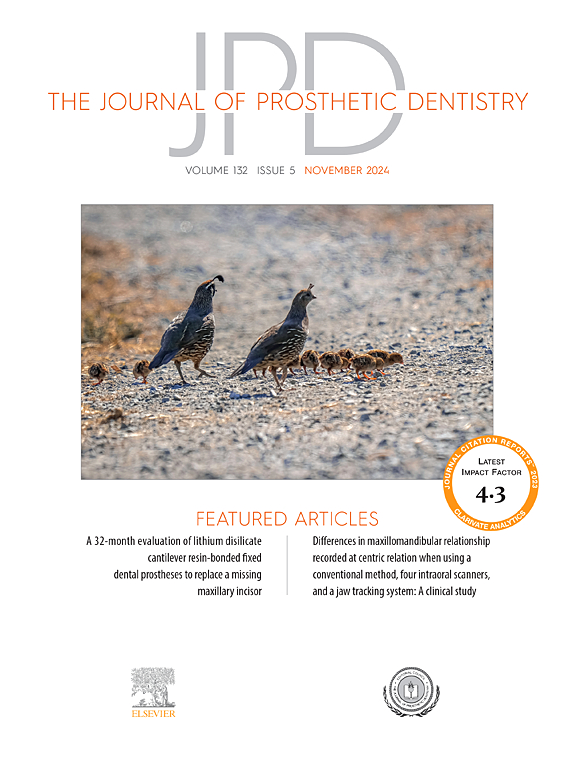Analysis of the marginal gap and internal fit accuracy of 3D printed zirconia crowns using the triple scan protocol
IF 4.8
2区 医学
Q1 DENTISTRY, ORAL SURGERY & MEDICINE
引用次数: 0
Abstract
Statement of problem
Zirconia restorations must achieve micrometer-level accuracy in both marginal and internal fit to ensure an adequate fit with the abutments and to reduce the likelihood of clinical failure. Limited research exists on the fit accuracy of 3-dimensionally (3D) printed zirconia crowns, hindering the confirmation of additive manufacturing’s effectiveness in producing zirconia restorations.
Purpose
The purpose of this in vitro study was to analyze the marginal gap and internal fit of zirconia crowns fabricated through 3D printing compared with those manufactured by traditional milling.
Material and methods
A mandibular typodont tooth was prepared to receive a monolithic zirconia crown, and 24 epoxy resin replicas were obtained and scanned with a dental laboratory scanner. Using a computer-aided design (CAD) software program (Dental CAD 3.0; evoked GmbH), 24 identical zirconia crowns were designed and sent for additive (LithaCon 210 3y; Lithoz GmbH) and subtractive (Nacera Zirconia; Dental Direkt) manufacturing. The triple scan protocol was used to evaluate the marginal gap and internal fit of all zirconia specimens. All scans were obtained using a laboratory optical scanner (Medit T710; Medit Corp). The resulting STL files of each specimen were superimposed and analyzed using a 3D analysis software program (Medit Design v.2.1.4; Medit Corp). Heat maps were generated to represent all deviations. An independent (nonpaired) t test was performed to compare the fit of crowns fabricated with both techniques (α=.05).
Results
The 3D printed zirconia crowns exhibited a significantly higher marginal gap (87.7 ±7.4 µm) compared with the milled crowns (57.5 ±7.0 µm) (P<.05). Similarly, the internal gap was greater in the 3D printed group (107.4 ±4.9 µm) than in the milled group (86.6 ±7.6 µm) (P<.05).
Conclusions
While 3D printed zirconia crowns demonstrated higher marginal and internal gap values compared with the milled crowns, both types were within clinically acceptable limits.
三维打印氧化锆冠边缘间隙及内部配合精度分析
问题说明:氧化锆修复体必须在边缘和内部贴合上达到微米级的精度,以确保与基台充分贴合,并减少临床失败的可能性。3D打印氧化锆冠的贴合精度研究有限,阻碍了增材制造在氧化锆修复体生产中的有效性的证实。目的:通过体外研究,比较3D打印制作的氧化锆冠与传统铣削制作的氧化锆冠的边缘间隙和内部配合。材料和方法:制备一颗下颌骨排印牙,接受整体氧化锆冠,并获得24颗环氧树脂复制品,用牙科实验室扫描仪扫描。采用计算机辅助设计(CAD)软件程序(Dental CAD 3.0;诱发GmbH),设计了24个相同的氧化锆冠并送去添加剂(LithaCon 210 3y;Lithoz GmbH)和减法(Nacera Zirconia;牙科用品制造。采用三重扫描方案评估所有氧化锆试样的边缘间隙和内部配合。所有扫描结果均使用实验室光学扫描仪(Medit T710;Medit Corp .)。将得到的每个标本的STL文件进行叠加并使用3D分析软件程序(Medit Design v.2.1.4;Medit Corp .)。生成热图来表示所有偏差。采用独立(非配对)t检验比较两种技术制作的冠的配合度(α= 0.05)。结果:3D打印的氧化锆冠的边缘间隙值(87.7±7.4µm)明显高于磨牙冠(57.5±7.0µm)。结论:3D打印的氧化锆冠的边缘间隙值和内部间隙值均高于磨牙冠,但均在临床可接受的范围内。
本文章由计算机程序翻译,如有差异,请以英文原文为准。
求助全文
约1分钟内获得全文
求助全文
来源期刊

Journal of Prosthetic Dentistry
医学-牙科与口腔外科
CiteScore
7.00
自引率
13.00%
发文量
599
审稿时长
69 days
期刊介绍:
The Journal of Prosthetic Dentistry is the leading professional journal devoted exclusively to prosthetic and restorative dentistry. The Journal is the official publication for 24 leading U.S. international prosthodontic organizations. The monthly publication features timely, original peer-reviewed articles on the newest techniques, dental materials, and research findings. The Journal serves prosthodontists and dentists in advanced practice, and features color photos that illustrate many step-by-step procedures. The Journal of Prosthetic Dentistry is included in Index Medicus and CINAHL.
 求助内容:
求助内容: 应助结果提醒方式:
应助结果提醒方式:


